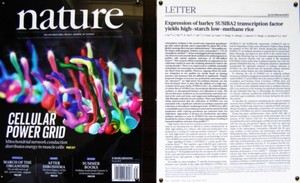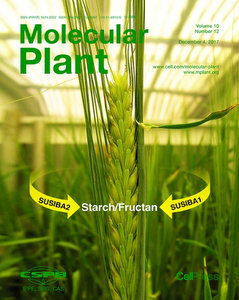Facts:
Chuanxin Sun, Associate Professor in molecular cell biology, Department of Plant Biology, Uppsala BioCenter, Linnean Center for Plant Biology, SLU, P.O. Box 7080, SE-750 07 Uppsala, Sweden. Contact information:
Tel: +4618 673252.
Research expertise in: Plant molecular biology, genetics, biotechnology and breeding. Research vision is to produce more and better with less environmental impact. Research interests are in carbon metabolism and allocation related to quantity (yield) and quality (dietary fiber, starch and oil) production, plant-soil microbe interaction, crop biotic stress tolerance, seed vigor and panicle development using cereals (barley, rice, oats and wheat), tobacco and Arabidopsis as research plants
The new carbon-metabolic crops for the future: Our version is to develop crops to produce more and better biomass materials with less environmental impact. We use rice, barley, tobacco and Arabidopsis as model plants to direct carbon flux to different biomass products, such as lipids, starch and dietary fibers. The new carbon-metabolic crops with novel traits have different applications in industries and agriculture.
Low-methane rice: Using transcription factor technology we have successfully generated the world´s first low-methane rice, SUSIBA2 rice (Su et al 2015, Nature 523, 602-606 and Figure 1). SUSIBA2 rice can reduce over 90% of methane emissions from rice paddies and increase yield more than 10%. If the world adopts SUSIBA2 rice in global rice cultivation, it would generate an effect of removing 200 millions of cars from the road and feed additional 700 million people.
WRI1 rice: Overexpression of Arabidopsis transcription factor WRI1 in rice endosperm has led to an oil content increase from ca 1% to 2% in rice seeds. Theoretically this will bring 10 million tonnes of oil annually from global production of one billion tonnes of rice.
In barley, we have found a molecular yin-yang system that directs carbon flux between starch and dietary fibers (Jin et al 2017, Molecular Plant 10, 1556-1570 and Figure 2). Using the yin-yang system, we have achieved five lines of yin-yang barley via screening and crossbreeding. The yin-yang barley has over 25% of dietary fiber content. They are on the field trials under development to new varieties for agricultural production.
Using different combination of genes encoding fatty acid reductase and wax ester synthase, we are able to produce different quality and quantity of wax esters in tobacco chloroplasts (Aslan et al 2014, Metabolic Engineering 25, 103-112; Aslan et al 2015, Transgenic Research 24, 945-953). Using vegetative tissues of crops for energy-rich biomass production would bring dual benefits, i) solving the problem of agricultural residues such as straws, ii) generating bioenergy.
We have demonstrated that overexpression of a gene from Agrobacterium in Arabidopsis can allocate more carbon to oil synthesis and less carbon to polysaccharide synthesis (Jin et al 2017, Biotechnology for Biofuels 10, 19). The finding has a potential in increasing oil yield in oil crops.

Figure 1. In 2015, Nature, Vol 523 published the first low-methane and high-yield rice, SUSIBA2 rice, invented by the C4F program, SLU (Su et al 2015, Nature 523, 602-606).

Figure 2. In 2017, the cover of Molecular Plant, Vol 10 showed the finding of a molecular system that orchestrates synthesis of dietary fibers and starch in barley from the C4F program (Jin et al 2017, Molecular Plant 10, 1556-1570).
Jin Y, Fei M, Rosenquist S, Jin L, Gohil S, Sandström C, Olsson H, Persson C, Höglund AS, Fransson G, Ruan Y, Åman P, Jansson C, Liu C, Andersson R, Sun C (2017). A Dual-Promoter Gene Orchestrates the Sucrose-Coordinated Synthesis of Starch and Fructan in Barley. Molecular Plant 10, 1556-1570 and cover image.
Jin Y, Hu J, Liu X, Ruan Y, Sun C, Liu C (2017). T-6b allocates more assimilation product for oil synthesis and less for polysaccharide synthesis during the seed development of Arabidopsis thaliana. Biotechnology for Biofuels 10, 19.
Su J, Hu C, Yan X, Jin Y, Chen Z, Guan Q, Wang Y, Zhong D, Jansson C, Wang F, Schnürer A, Sun C (2015). Expression of barley SUSIBA2 transcription factor yields high-starch low-methane rice. Nature 523, 602-606 as a featured paper.
Aslan S, Hofvander P, Dutta P, Sitbon F, Sun C (2015). Transient silencing of the KASII genes is feasible in Nicotiana benthamiana for metabolic engineering of wax ester composition. Scientific Reports 5, 11213.
Aslan S, Hofvander P, Dutta P, Sun C, Sitbon F, (2015). Increased production of wax esters in transgenic tobacco plants by expression of a fatty acid reductase:wax synthase gene fusion. Transgenic Research 24, 945-953.
Källman A, Bertoft R, Koch K, Sun C, Åman P, Andersson R (2015). Starch structure in developing endosperm. International Journal of Biological Macromolecules 81, 730-735.
Xie Z, Sundström JF, Liu C, Jansson C, Sun C (2014). A selection strategy in plant transformation based on antisense oligodeoxynucleotide inhibition. Plant Journal 77, 954-961.
Aslan S, Sun C, Leonova S, Dutta P, Dörmann P, Domergue F, Stymne S, Hofvander P (2014). Wax esters of different compositions produced via engineering of leaf chloroplast metabolism in Nicotiana benthamiana. Metabolic Engineering 25, 103-112.
Nemeth C, Andersson AAM, Andersson R, Mangelsen E, Sun C, Åman P (2014). Relationship of grain fructan content to degree of polymerisation in different barleys. Food and Nutrition Sciences 5, 581-589.
Zhang M-Z, Fang J-H, Yan X, Liu J, Bao J-S, Fransson G, Andersson R, Jansson C, Åman P, Sun C (2012). Molecular insights into how a deficiency of amylose affects carbon allocation-carbohydrate and oil analysis and gene expression profiling in the seeds of a rice waxy mutant. BMC Plant Biology 12, 230.
Sathish P, Sun C, Lönneborg A (2012). In Mutant and Transgenic Plants. Progress in Botany: Structural Botany Physiology Genetics Taxonomy Geobotany 56, 301.
Nalawade S, Nalawade S, Liu C, Jansson C, Sun C (2012). Development of an efficient tissue culture after crossing (TCC) system for transgenic improvement of barley as a bioenergy crop. Applied Energy 91, 405-411.
Chuanxin Sun, Associate Professor in molecular cell biology, Department of Plant Biology, Uppsala BioCenter, Linnean Center for Plant Biology, SLU, P.O. Box 7080, SE-750 07 Uppsala, Sweden. Contact information:
Tel: +4618 673252.